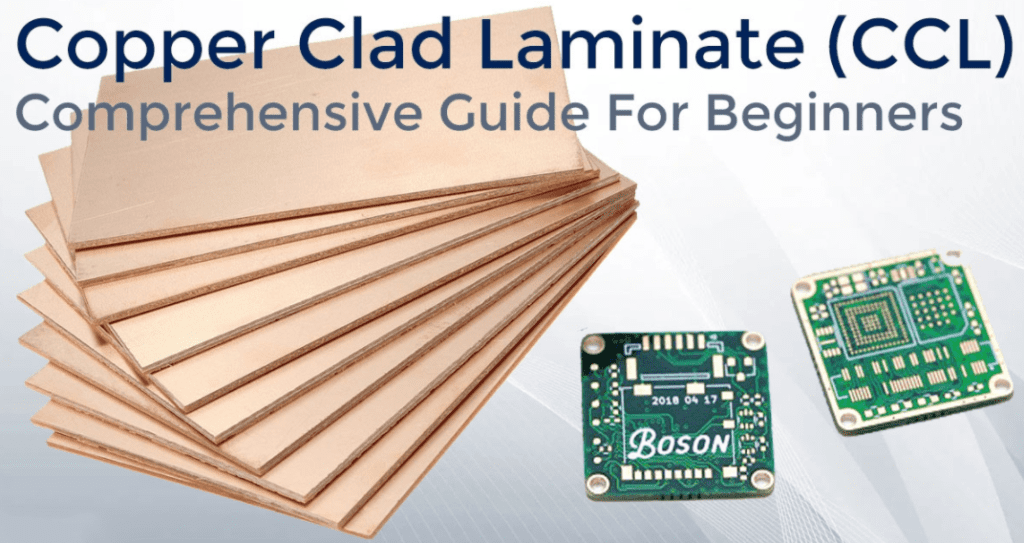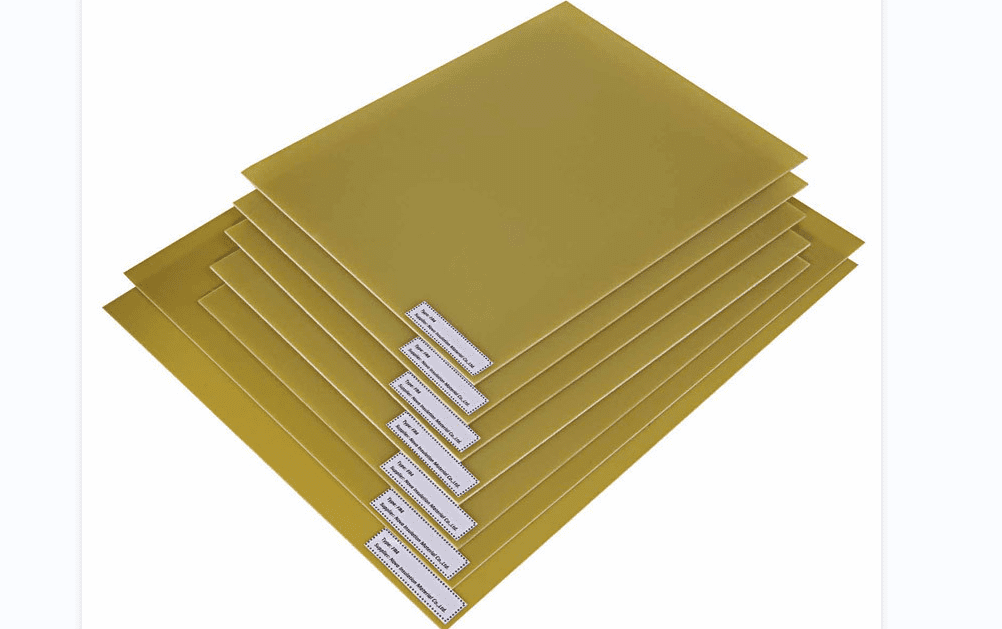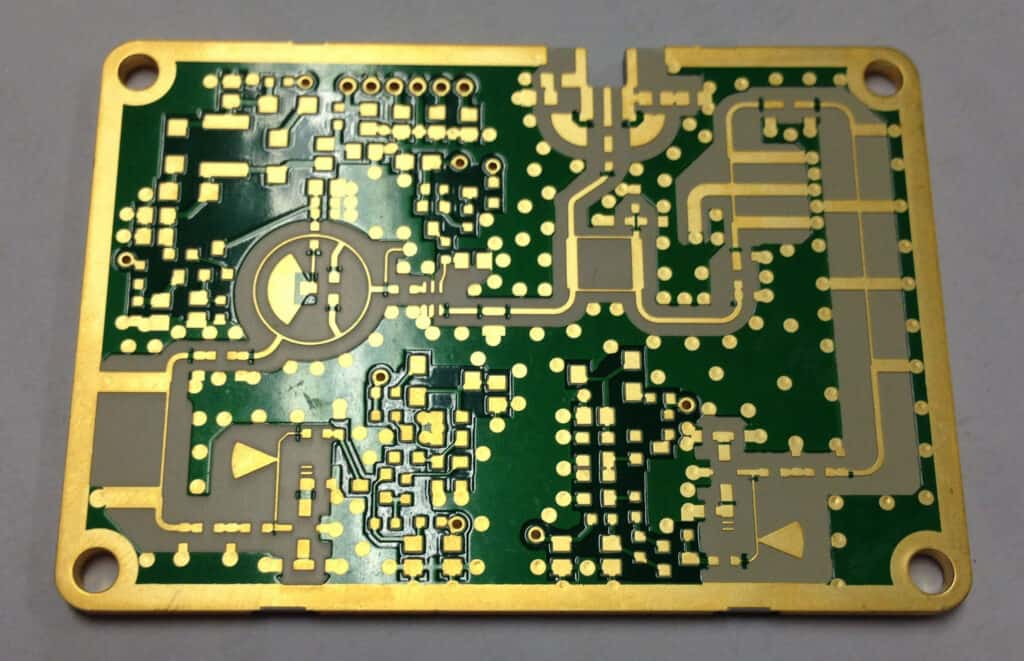Are you looking for materials for PCB Laminate, or are you trying to decide what type of material to utilize for your PCB? If yes, then we will discuss all the PCB lamination options currently on the market will be covered in this blog post.
We will tell you the benefits and drawbacks of each option and help you select the best one for your task. Read on to find out more about PCB laminates, whether you’re just starting out in engineering.
By applying heat and pressure, a prepreg sheet is bonded to the PCB to create a laminate. PCB laminate sheet and copper foil are usually laminated together by first being heated and then subjected to pressure on both sides. These printed circuit board laminates are called copper-clad laminates (CCL).
The material of a PCB laminate and bonding materials are crucial to the fabrication qualities, longevity, and performance of the board. Several PCB laminate materials are now in use. The most common materials, however, are FR4, High glass transition (Tg) Epoxy, Bismaleimide Triazine (BT) Epoxy, and Polyimide. Making the PCBs application-centric and efficiently begins with the material selection. The properties such as thermal, mechanical, or chemical of PCB laminate materials are discussed in this post for your benefit.
What is a PCB Laminate?
Your PCB manufacturer’s design and development process will benefit greatly from your knowledge of the many lamination options for printed circuit boards. The reliability and functionality of your PCB will depend on the laminate you use.
What keeps the PCB’s laminated layers together is the board itself. Typically, a circuit board will have four layers: the substrate, copper, solders mask, and silkscreen (from bottom to top). To achieve a consistent laminate thickness, the fabric is cured in a pressurized oven with a thermoset resin.

Laminates are commonly identified by the following notation: FR-4. This laminate has the qualities indicated by the numbers and letters above. Fire resistance, tensile strength, transition temperature, and thickness variation with temperature are all crucial features (the Z-axis expansion coefficient).
Below is a list, in order of frequency of occurrence, of the various PCB laminates and the PCB materials required for each. The resin used to make the laminate gives it its name.
· FR-4
Because of its high performance across the board, FR-4 is the most used laminate. This material retains its mechanical characteristics, excellent electrical properties, and physical qualities even when heated, and it has a high strength-to-weight ratio and is flame resistant, both of which boost its dependability.
· FR-4 High-performance
When working with multiple PCB layers, you should use a high-performance FR-4 laminate. Due to its low dielectric characteristics and high TG, it is well-suited to high-frequency circuits.
· Tg – High glass transition Epoxy
The High Tg Epoxy is the best choice for multilayer PCBs. Similar to the melting point, the Tg is known as the vitrification temperature. A greater value makes for a stiffer board. Heat and chemical resistance, as well as greater stability, characterize materials with TGs above 170 °C.
· BT – Bismaleimide Triazine Epoxy
When it comes to lead-free printed circuit boards, the BT Epoxy laminate is your best bet due to its exceptional thermal, mechanical, and electrical qualities. Most multilayer PCBs use this laminate. The binding will also remain strong even when heated.
· Polyimide
Extreme environmental stability is produced by this sort of laminate. When working with multilayer PCBs, rigid-flex circuit boards, or high-density flexible circuit boards, Polyimide laminate is the material of choice.
The thermal, chemical and mechanical qualities it generates are likewise exceptionally high. Military, aerospace, automotive, and consumer electronics are just some of the cutting-edge fields where polyimide laminates shine.
· CCL – Copper Clad
Reinforcing material in Copper Clad laminate can be either glass fiber or wood pulp paper. Considerations like size, shape, electrical, physical, chemical, and environmental performance lead most people to choose a CCL laminate for high-voltage circuits.
· Teflon
The gold standard for use in radio and television transmissions. There is a wide variety of Teflon materials available. However, manufacturing Teflon PCBs with woven glass is the most user-friendly for factories. Teflon printed circuit boards (PCBs) present a number of difficulties for the typical board manufacturer.
Importance of Printed Circuit Board Material in the Fabrication
A printed circuit boards (PCB) foundation is the laminate it is made from. During operations, these laminates are subjected to mechanical, electrical, chemical, and thermal stresses.
Thus, it is necessary to think about things like durability against scratches, chemicals, electric shocks, vibrations, wetness, etc.
Only by investigating the characteristics of a laminate material can printed circuit boards be tailored to the specific needs of a certain application. Because of this, reliable, high-performance PCBs may be made.
Properties of Laminate Material in fabricate printed circuit boards
So that they can withstand any kind of environmental assault, there are four distinct groups of PCB laminate qualities.
Let’s talk about the characteristics shared by these four classes.
Mechanical Properties
There are many factors to think about while working with laminates, but one of the most important is the material’s mechanical qualities.
- Peel Strength: Peel strength refers to the adhesive force between the laminate layers and the copper. The risk of delamination decreases as peel strength increases.
- Flexural Strength: Laminates have excellent flexural strength because they can repeatedly bend without breaking. This is a crucial value for PCBs that can bend.
- Delamination Time: After subjecting to stress, how long it takes for a material to start peeling apart? A longer delamination period will result in greater durability.
Chemical Properties

For different laminate materials, the following chemical characteristics are of critical importance.
- Flame Resistance: If your subject the PCBs to heat application, the flame resistance of the laminate should be taken into account.
- Moisture Absorption: Delamination occurs more quickly when the laminate absorbs moisture. Laminate is resistant to water and delamination because it has a low moisture absorption property. We recommend that PCB laminate materials should have a moisture absorption rate of between 0.01% and 0.2%.
- MCR: PCB laminate with excellent resistance to methyl chlorine will have a wide chemical tolerance. Because of this, the material has a high chemical absorption rate.
Electrical Properties
When choosing a laminate, it is crucial to consider its electrical qualities. It provides the excellent electrical insulation.
- Dielectric Material Properties: In this context, the dielectric material and dielectric loss tangent are crucial factors to think about. Avoid material losses on exposure to electric shocks if these conditions are kept within an acceptable range.
- Insulating Properties: The two most important measures of electrical resistance are the surface and volume values. This guarantees the PCB’s security in the face of a sudden electric current.
- Electric Strength: This quality characterizes a material’s resistance to electrical breakdown. You should keep it at a constant high level.
Thermal Properties
As such, the following thermal qualities of laminate material must be taken into account.
- Higher Glass Transition Temperatures: The glass transition phenomenon describes the substrate’s softening and subsequent hardening within a narrow temperature range. The temperature at which a material undergoes a change in phase from solid to liquid is the glass transition temperature.
- Thermal Expansion: When heated above a particular point, the laminate will expand. Nonetheless, dimension changes and thermal strains in the PCB can be avoided by selecting a laminate material with low thermal expansion.
- Thermal Conductivity: For effective heat transfer, the material layer must have a high thermal conductivity.
- Decomposition Temperature: If you heat the substrate over a certain point, it will decompose. The decomposition temperature is a key attribute for selection because it is the temperature at which the process should be avoided.
Things To Consider While Choosing The PCB Laminate Material for lamination process
After getting a basic understanding of the fundamentals of laminate material for printed circuit boards, here are some points to keep in mind while making your final decision:
· Cost:
The cost is always a major component in the board selection process. For the finest final PCB material, you should weigh the price against the other criteria listed below.
· Availability:
Laminate materials for printed circuit boards vary in how readily they can be obtained. When making your decision, you should think about how this might affect the project’s overall budget and timeline.
· Performance:
The performance of the laminate material used for printed circuit boards is crucial. To make the best choice, think about the thermal conductivity, dielectric constant, and other properties of the materials you’re considering.
• Lead Time:
The lead time of your Printed Circuit Board (PCB) materials may have an effect on the schedule of your entire project. Don’t forget to account for this when making a decision.
• Choosing the Right Materials for PCBs:
After learning about the most common PCB materials, we may go on to explore some of the other options available. Which of these methods of PCB assembly do you think is the best? You need to give this a lot of consideration. You may see this in action with the following examples:
• Dielectric Materials Constant:
The dielectric constant of the PCB materials is an important property. As an added bonus, this value is significant for high-speed applications since it shows how much a material can slow down electrical impulses.
• Thermal Performance:
The thermal performance of the PCB material is another factor to think about. Do soldering or other high-temperature operations need to be performed in your application? Be sure that the PCB laminate materials you select can handle those high temperatures.
• Thermal expansion CTE
The coefficient of thermal expansion is a measure of how much a material will expand or contract when heated, and it is crucial to know the CTE value of the PCB laminate materials you’re using. It is also vital to select a PCB laminate material with a CTE value that is suitable for your intended use.
• Transition Temperature:
If you heat the PCB laminate materials over the transition temperature, their characteristics will change. It is vital to know the transition temperature of the material you are using, as some PCB laminate materials, for example, become brittle at high temperatures.
• Thermal Conductivity:
Printed Circuit Board (PCB) laminate materials’ thermal conductivity values reveal their performance in this regard. This factor has an impact on your device’s overall performance. One cannot ignore this factor.
• Electrical Performance:
You should think about how the electrical performance of the PCB laminate materials will affect the functionality of your device as a whole.

• Flame Retardancy:
The fire resistance of PCB laminates is crucial. The ability to endure high temperatures is crucial when considering the usage of PCB laminate materials in heat-generating devices.
• Dimensional Stability:
There should be PCB laminate material’s thermal expansion coefficient and its water absorption rate instability. While designing a device, it’s also crucial to think about the dimensional stability of the PCB laminate materials you’re using.
• Tg
One can enhance the dimensional stability of materials by a higher glass transition temperature (Tg).
Frequently Asked Questions
How is it possible that material data sheets are different from dielectric constants on the same circuit boards?
The dielectric constants listed on a data sheet are useful for different applications and not just one or two specific materials. A laminate has four distinct layers. Dielectric constants may vary among layers even when they are all stacked together.
Is it possible to do a higher layer count by using only materials of high frequency?
High-frequency stack-ups are conceivable and sometimes even necessary. How important it is and what kind of requirements there are for signal integrity are decisions that can only be made by you.
Can high-frequency materials v-score?
The standard response is negative. Soft and fibrous are typical of high-frequency laminate materials. Two circular saws placed side by side can create a “V” shape. If you try to use them on a delicate surface, you’ll quickly discover how weak they are.
If materials of high-frequency are not available, how long will they take to be available?
How long it takes depends on a number of things, including how difficult it is to keep supplies of the laminate material in store. The wait time could be anywhere from a few days to a couple of weeks. A timely order for the necessary materials is essential. There are different printed circuits material suppliers who supply materials quickly such as Ray PCB.

